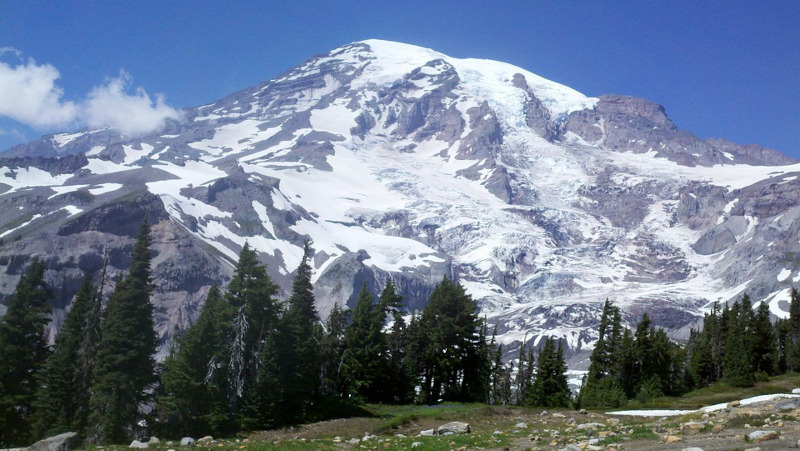
Mount Ranier Facts
- This magnificent natural feature currently bears the name of Mount Ranier. Originally, it bore several other names in the language of the local Native Americans. Those names, used for centuries, consisted of the three terms of Tahoma, Tacoma, and Talol.
- The first known outsiders to view the site did so as part of a surveying mission by Captain George Vancouver, of the British Navy, in 1792. He named it in honor of his friend, Peter Ranier. The Lewis and Clark expedition also saw it between 1804 – 1806.
- This geological marvel further stands out for a variety of reasons. For starters, it ranks as the highest mountain in its portion of the country in which it formed. This behemoth of natural processes also qualifies as the tallest peak in the range in which it sits.
- Its impressiveness doesn’t simply end there, however. That’s because it also ranks as the most topographically prominent mountain in its immediate part of the globe. It’s also the tallest peak in what now bears the name of Cascade Volcanic Arc.
- That’s right, this site is actually a volcano. In fact, it forms one of 16 volcanoes listed on the Decade Volcano list. The stunning Mount Ranier actually remains a technically active volcano! It’s also considered among the most dangerous on earth.
- The last confirmed activity of the volcano occurred between 1820 – 1854. Given the population of the surrounding region, an estimated 80,000 people are at risk if another eruption occurred. A large scale eruption would also affect other nearby regions.
Related Articles
Mount Ranier Physical Description
In the minds of most individuals who encounter it, the most notable characteristic of Mount Ranier likely remains its sheer size. This peak possesses a height measuring 14,411 ft (4,392 m) at its highest point. Its great height isn’t the only reason the site stands out, though.
That’s due to the nature of the region surrounding it. Relative to the lowest region around it, it ranks as the highest of any point in its region of the world. It additionally has a proportionately great width, making for an outline that stands out for any who see it.
More precisely, the total area of the base of this majestic formation measures an astonishing 100 sq mi (259 sq km). At its top, however, yet another volcanic feature captures one’s attention. Amazingly, the summit possesses not one, but two incredible craters.
Each of these wonders measures more than 1,000 ft (300 m) in diameter. The one on the eastern side measures slightly larger than the one on the western side. The eastern of the mountain on also slightly overlaps the one formed on the western side of the volcano.
In the western crater, though, yet another feature merits attention. That’s due to the fact that, here, a small crater lake exists. This roughly rectangular measures roughly 130 ft x 30 ft (39.6 m x 9.1 m). It’s shallow, however, only averaging around 16 ft (5 m) in total depth.
Mount Ranier Location, Geology, and Ecology
The breathtaking Mount Ranier formed in a region of the Northern Hemisphere well known for geological activity. In fact, it lies only about 90 mi (145 km) from Mount Saint Helens. More precisely, it sits in the state of Washington, in the United States, in North America.
Its exact location, in fact, further places this remarkable stratovolcano only 54 mi (87 km) southeast of the city of Seattle. Its height, combined with the nature of the local geography, means that in clear weather it’s possible to see it from Portland, Oregon, 135 mi (217 km).
The majority of the mass of this fabulous volcano consists of a combination of debris flows, lava flows, and pyroclastic ejecta. Geological evidence indicates that the mountain began forming roughly 840,000 years ago. Most of its mass now is about 500,000 years old.
Astonishingly, most of its outer surface area has a covering of permanent snowfields and glaciers. Incredibly, a total of 26 major glaciers presently cover much of the mountain. Due to this, it ranks as the most heavily glaciated site in the continental United States.
Fortunately, the entirety of Mount Ranier lies within the boundaries of the Mount Ranier National Park. The government of the country established this site as its 5th National Park, on March 2, 1899. This therefore provides it with a measure of protection.
The surrounding region thus provides a safe haven for numerous species of flora and fauna. Some of these are not only endemic, but appear nowhere else. The area further possesses a highly diverse ecosystem, due to differing climates at varying altitudes.
Fields surrounding the volcano have a gorgeous covering of varied wildflower varieties. The region also boasts large forests, some great in age. A vast array of insects and animals also live here, including 65 types of mammals, along with many birds and reptiles.
Features Sharing Its Region
Check out our other articles on 6 Captivating European Caves, Reef Manta Ray, Saint Mary’s Islands, White-Nosed Coati, Kentia Palm, Harpy Eagle, California Mantis, Anegada ground iguana
